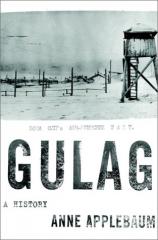Gulag: A History
Review
Gulag: A History
In 1973, when Alexander Solzhenitsyn launched the first volume of
his monumental GULAG ARCHIPELAGO, an oral history of Soviet
concentration camps, he expressed concern that a proper history of
the camps might never be written, that those who do not wish to
recall would destroy all the documents "down to the very last
one."
As it happened, however, the documents were not destroyed; they
remained locked away in files and archives. Nor did Solzhenitsyn
foresee the coming of Mikhail Gorbachev and the advent of
glasnost, his policy of openness, much less the unfettered
availability of Gulag information and the flood of memoirs by camp
survivors.
It was an American Sovietologist-turned-journalist, Anne Applebaum,
now a Washington Post columnist, who embraced the unexpected
opportunity to undertake this vast and daunting project from which
whole universities of ordinary researchers might have slunk away in
dismay.
Lenin himself, the founding father of Russian communism,
established the first 84 camps of the Soviet Gulag almost
immediately after the Russian Revolution, basing their design on
tsarist precedents. Lenin's successor, Josef Stalin, presided over
the Gulag's development into the far-reaching "archipelago" of
which Solzhenitsyn wrote.
Transport to the camps was no less nightmarish in many cases than
the camps themselves. Prisoners en route to distant camps are said
to have frozen to death even before they were loaded into the
cattle cars, where they would sometimes remain crowded together for
more than a month. Memoirs tell of trains being stopped to take off
corpses, which were thrown into ditches.
The struggle for survival was part of daily life in the camps, the
struggle for bits of food, edible but often revolting, and for
enough water to sustain life. In many camps, hardened criminals
were part of the general population of politicals and other
"enemies" who had committed no crime other than happening to have
been born into the family of a relatively successful farmer. The
criminals stole, murdered and raped as they pleased, often with the
passive approval of the guards.
The Gulag's growth continued throughout World War II and into the
early 1950s, by which time there were 476 distinct camp complexes
comprising thousands of individual camps. The number of prisoners
in each camp ranged from hundreds to thousands. From 1929, when the
Gulag began its major expansion, until 1953, when Stalin died, some
18 million people passed through the camp system. More than three
million of them perished.
Comparatively few of the Gulag prisoners (zeks) had been
criminals in the conventional sense of the word. Some of them were
arrested because a neighbor had heard them pass along an
unfortunate joke or laugh at one, some because they had been seen
engaging in "suspicious" behavior, and others were reported for
having been ten minutes late for work or owning four cows in a
village where other families owned only one. Some were members of a
population category --- Poles, Balts, Chechens, Tartars, etc. ---
that had suddenly fallen into disfavor. Immigrants were always
suspect, as were ordinary Soviet citizens with foreign connections
--- stamp collectors, Esperanto enthusiasts, anyone having
relatives abroad, or a returned POW. In short, the smallest
statistical possibility of guilt was sufficient cause for arrest
and conviction.
In 1937, the secret police launched an all-out campaign to
extirpate a Polish spy ring allegedly operating in the Soviet
Union. The secret police arrest order, which included virtually
everyone of Polish background living on Soviet soil, specified that
investigation was to begin at the time of arrest, not before, as a
means of expediting the process.
This transposition of procedural steps, Applebaum explains, meant
the arrestees themselves would be forced to provide the evidence
upon which the case against them would be built. More bluntly, she
says, they were to be beaten or otherwise tortured until they
"confessed" the role they had played in the apparently fictitious
spy ring. Their testimony naturally implicated others, who were
also arrested and similarly forced to confess whatever acts of
espionage they could imagine having committed.
One of the larger questions with which Applebaum grapples is
whether the Gulag system developed haphazardly, through simple
accretion in response to a need for additional space for prisoners,
or as part of an elaborate plan. Was it intended primarily as
storage space for undesirable elements in Soviet society, or as an
apparatus for collecting slave laborers and putting them to work on
projects, such as the White Sea Canal and the opening of the
Siberian north?
Scholars disagree, and evidence seems to support both sides. On the
one hand, Peter the Great, whom Stalin obsessively admired, used
serfs and prison labor to accomplish enormous construction projects
at relatively little expense. Planned or not, the Gulag became
immensely important as a source of virtually free labor. A Soviet
historian has identified a correlation between the successful
economic activity of the camps and the number of prisoners sent to
them. His book also points out that sentences for petty crime
became much harsher at a time when more prison laborers were
urgently needed. Another example: In March 1934 the head of the
secret police, G.G. Yagoda, wrote to subordinates in Ukraine
ordering them to produce 15,000-20,000 prisoners, all fit to work,
to help complete work on the Moscow-Volga Canal.
As pure history, GULAG is a major achievement. It also fulfills the
moral imperative to expose, document, and record in service to the
collective memory the fate of so many millions of human beings torn
from their families who suffered and died in hostile places far
from their homes. Fittingly, Applebaum's book is dedicated to her
predecessors who described what had happened and thereby made
possible this monumental work.
Reviewed by Hal Cordry on January 22, 2011
Gulag: A History
- Publication Date: April 29, 2003
- Genres: History, Nonfiction
- Hardcover: 720 pages
- Publisher: Doubleday
- ISBN-10: 0767900561
- ISBN-13: 9780767900560




